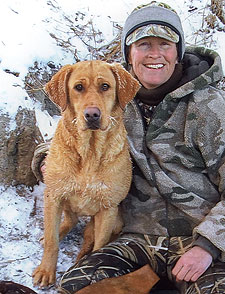By James B. Spencer
 This tip is from Cindy Huff of Top Notch Kennel, P.O. Box 561, 2404 East 1775 South, Gooding ID 83330; e-mail topnotchkennel1@aol.com. Cindy has been training professionally for 25 years. She trains all sporting breeds for hunting, but specializes in training retrievers for field trials and hunt tests. She is on the Board of Directors of the Professional Retriever Trainers Association (PRTA). She is also an obedience instructor and has handled dogs of many breeds in conformation competition. She breeds Labradors. |
"An issue that comes up frequently, before, during, and after hunting season," Cindy said, "is a retriever's failure to complete retrieves. He may not bring the bird all the way back to the owner or, if he does, he may not to deliver it properly to hand. He may drop it at the owner's feet. He may play keep-away with it. He may even develop a mouthing problem. Then, too, some dogs give up on a blind retrieve and come back in without the bird."
Cindy stressed that in her experience, such dogs are usually well-bred, have lots of natural talent, as well as drive and desire. She also stressed that the owners have usually raised and socialized these dogs quite well and that they are a pleasure to be around.
However, the owners have not instilled sufficient discipline, which requires a delicate balance between teaching, correcting, and praising. Therefore their dogs do well in those things that come naturally from their genes, but falter on those things that must be formally taught by the owner.
"Such a retriever," Cindy said, "has a strong desire to please, but he also carries an 'independent contractor's license!'"
The dog has been enjoying the good life in the family room with the kids, which is great.
However, as the owner's hunting buddy, he also needs consistent discipline combined with regular and properly designed drills as well as field work.
"Most of these delivery problems have developed," Cindy said, "as a result of overall laxity in discipline, especially in force-fetch training."
As a preventative, Cindy recommends enhancing the force-fetch regimen with walking-fetch, stick-fetch, stick-to-pile, and forcing to a pile, followed by three-handed casting and the collar-fetch, after collar-conditioning. (Contact a retriever pro for a full explanation of these terms.) To learn how to use these training routines properly and effectively, the beginner should seek the guidance of an experienced trainer.
| More Tips | 

Don't miss part one of our story with tips for your retriever here, and your spaniel, here.
|
|
"This is an area," she said, "where a pro's timing and experience will produce big payoffs for you and your dog in the future."
Cindy said that failure to complete force-fetch training with these drills before going further in the overall training process can lead to all sorts of nasty problems: "No-Go's," in which the dog refuses to leave the owner's side when sent to retrieve, especially on blind retrieves; "popping," in which the dog, after being sent to retrieve, stops on his own (with no whistle signal from his owner) and asks directions to the bird; "bugging," in which, to avoid the situation before being sent, the dog refuses to look out in the field before him, where his owner intends to send him.
To better understand the overall training program, Cindy recommends that you visualize a set of building blocks.
"Good solid basics are your dog's foundation," she said. "On these you'll add other training blocks to enhance his abilities. If the foundation isn't well laid, at some point it will crumble and become what we call a 'hole,' which if not corrected, will cause problems to ripple throughout your dog's active life."
She stressed that consistency is critical throughout the training program. She said that five minutes every day is better than 15 minutes every other day. Dogs learn at different speeds, so the owner should keep in mind that, throughout the program, being thorough is more important than being quick. Consistency also demands that you see to it that your dog obeys each command every time you give it, not only when he feels like it. He should also obey each command immediately every time.
"When you say 'Sit,'" she said, "your dog should sit instantly, and he should stay sitting there, regardless of distractions, until you tell him to do something else."






